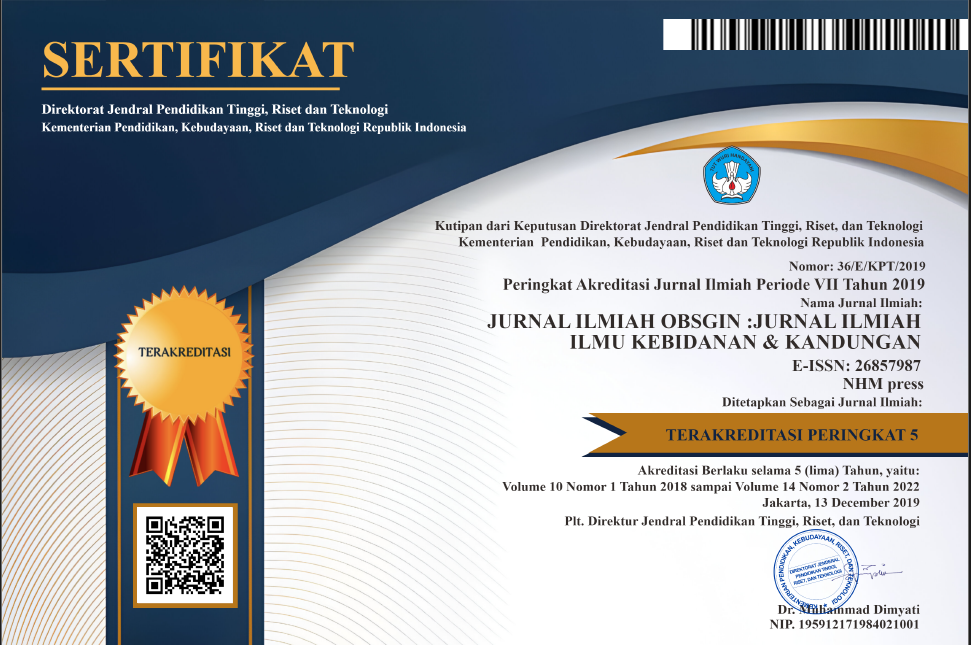DESCRIPTION OF PREGNANT WOMEN'S CHARACTERISTICS THAT DO NOT EXAMINATE HIV / AIDS AND HBSAG IN INTEGRATED ANTENATAL CARE SERVICES IN THE CIPARAY PUSKESMAS
Abstract
One of the contributors to the maternal mortality rate is HIV / AIDS and Hepatitis B, although research in 8 Indonesian provinces that have been carried out is relatively low but if left unchecked it will become a serious problem. To make prevention, the government has launched an HIV / AIDS screening program for pregnant women in government-owned Puskesmas or hospitals (hospitals), unfortunately, until now the coverage of the screening is still low (13.38%).This study aims to determine the description of the characteristics of pregnant women who do not conduct HIV / AIDS and HBSAg examinations in integrated antenatal care services in the working area of Ciparay Health Center, Bandung Regency in 2019.This research method is descriptive. The sample used was totally sampling, namely 40 pregnant women who did not carry out HIV / AIDS and HBSAg examinations. Analysis of the data used is univariate analysis.The results of the study note that the majority of pregnant women aged 20-35 years as much as 85%. More than half of them are pregnant with secondary education of 52.5%. Most pregnant women do not work as much as 80%. More than half of them are multiparous pregnant women with 65%. The majority of pregnant women have made <4 antenatal care visits with 87.5%.It is expected that health workers will motivate pregnant women to carry out HIV and HBSA tests and provide advice to mothers to register as participants of BPJS or other health insurance in order to ease the burden on mothers when there is a need for health services.
References
[2] DATA RP. Infromasi RKPDD Pusat Data Dan Infromasi Kementerian Kesehatan RI. In: Kesehatan K, editor. Jakarta 2016.
[3] PI DP. Laporan Situasi Perkembangan HIV dan AIDS di Indonesia. In: RI KK, editor. Jakarta2013.
[4] Cunningham, William. Obstetric. Jakarta: EGC; 2013.
[5] Manuaba. Kesehatan Reproduksi Wanita. Jakarta: EGC; 2008.
[6] I A. Bahan Ajar AIDS Pada Asuhan Kebidanan. Yogyakarta: Deepublish; 2014.
[7] Kesehatan K. Penyakit HIV/AIDS. In: Kesehatan K, editor. Jakarta2016.
[8] Astuti I. Jakarta: Media Indonesia. 2018. [cited 2019].
[9] Mulyanti S. Faktor-faktor yang berkontribusi pada perilaku Ibu hamil trimester 2 dan 3 dalam pemeriksaan HIV dan HBSAg. 2012:67.
[10] Dwi Mutia Wenny YW, Mohammad Hakimi Faktor yang mempengaruhi partisipasi Ibu hamil melakukan skrinning HIV dan HBSAg di Puskesmas Yogyakarta. BKM Journal Of Community Medicine and Public Health. 2016;32:435-42.
[11] Ernawati AS, Syamsulhuda BM. Niat Ibu hamil untuk tes HIIV dan HBSAg di UPT Puskesmas Alun-Alun Kabupaten Gresik. Promosi Kesehatan Indonesia. 2016;11.
[12] Bandung DKK. Profil Kesehatan Kabupaten Bandung. In: Bandung DKK, editor. Bandung: Dinas Kesehatan; 2018.
[13] Anak PKId. Data Pemeriksaan VCT dan HBSAg. In: Ciparay P, editor. Bandung2019.
[14] Oktavia N, Zainal E. Pelaksanaan Konseling pra-tes Meningkatkan Tingkat Pemahaman Ibu Hamil Tentang Pemeriksaan HIV dan Hepatitis B Kebidanan dan Keperawatan Aisyiyah. 2018;14:40-8.
[15] RI KK. Program Pengendalian HIV/AIDS dab PIMS Fasilitas Kesehatan Tingkat Pertama. In: RI KK, editor. Jakarta2017.
[16] Green CW. HIV, Kehamilan dan Kesehatan Perempuan: Yayasan Spiritia; 2015.
[17] Wijayanti IB. Efektifitas HBSAg- Rapid Screening Test Untuk Deteksi Dini Hepatitis B. KesMaDasKa. 2016.
[18] S A, Mardiatul, Ramalida. Asuhan Kebidanan Pada Kehamilan. Bogor: In Media; 2015.
[19] A A, Y K, K W. Hubungan Karakteristik Bidan dengan Mutu Pelayanan Antenatal Care Berdasarkan Standar Operasional. Jurnal Kesehatan Masyarakat Andalas. 2015;10.
[20] KKR I. Pedoman Antenatal Terpadu. In: RI KK, editor. Jakarta2013.
[21] RI K. Pedoman Pelayanan Antenatal Terpadu. In: RI KK, editor. Jakarta2010.











